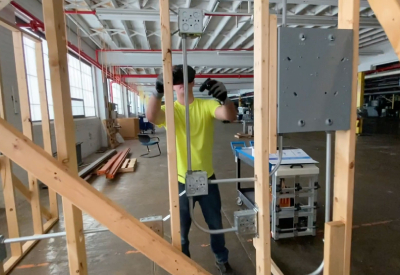IVRY Technologies, an IDEAL INDUSTRIES company, Launches VR Platform to Train the Next Generation of Electrical Students

Nov 27, 2020
According to the U.S. Bureau of Labor Statistics (BLS) and the National Electrical Contractors Association (NECA), the United States is expected to have a shortage of electricians in the near future. Statistically, the number of retiring electricians is outpacing the rate of new electricians entering the field, with 10,000 electricians retiring each year and only 7,000 entering the field in return.
As a result, this is producing a knowledge gap in the electrical industry, which creates the need for additional training resources to prepare the next generation of electrical tradesmen.
IVRY Technologies is the start-up Virtual Reality (VR) initiative created by IDEAL INDUSTRIES, INC. which is a global enterprise with companies serving technicians and workers across a wide range of industries, from electrical to construction to aerospace to automotive.
IVRY Technologies selected Groove Jones to develop an interactive training platform utilizing VR to train electrical apprentices on how to wire homes and commercial premises. The program, named VET (Virtual Electrical Training), can be customized for various training protocols, as well as complying with safety standards.
The initial product offering is designed to simulate the experience of an electrical apprentice training under the tutelage of a master electrician. The user is guided through the experience, first learning how to install a single-pole switch, and gradually advancing to more complex procedures, such as installing a three-way switch circuit.
{vimeo}https://vimeo.com/456234339{/vimeo}
The VET experience will teach the user pro-tips of the trade, such as troubleshooting techniques, how to use special tools, and industry code requirements.
Following each lesson, the apprentice will have the opportunity to demonstrate mastery of each skill.
Groove Jones has packed the VET program full of useful features that not only enhance a student’s ability to learn a trade remotely but also make it easy for educators to integrate measurable, metrics-based content into their learning curriculum.
The training program is equipped with scoring metrics and data analytics for the instructors and training directors to gauge progress. Students can also review their own scores to understand their personal strengths and areas of improvement.
In these virtual training lessons, students are challenged with real-world problems that electricians face every day.
The VET program increases student motivation and confidence by enabling them to make mistakes without consequences, learn about code, safety, troubleshooting, and best practices.
Access to this emerging technology will lead to higher student enrollment in the participating organizations and allows for increased testing capabilities with the growing demand for remote, virtual learning.
Instructors can allow students to perform virtual installations multiple times without any material waste, ultimately saving schools money and unnecessary resources.
 Tools of the Trade and Enhanced VR Tools
Tools of the Trade and Enhanced VR Tools
Groove Jones digitally recreated IDEAL tools that electricians use on the job site.
Blue Pin Drops are used as indicators to guide the students, making it easier to follow instructions throughout the experience. The visual indicators are then removed for students to self-evaluate.
VET includes a virtual tablet that is accompanied by voice instructions that guide the user through the experience.
The user’s progress is displayed on the tablet screen, showing the percentage of tasks completed.
Each lesson has an advanced close-up animation to show detailed pro-tips to help provide instruction during training via the tablet.
Real-Time Render and Fully Interactive Training Spaces
The Oculus Quest was used for production and development, which allowed the development team to create a fully interactive space. The lesson modules were focused within a 10’ x 10’ space, which resembled a commercial construction site.
Within the VR environment, we created numerous lessons to keep the user focused on the task at hand.
The real-time render interactions create a life-like experience, allowing the students to learn by doing. The repetition of steps increases muscle memory and adds to the overall learning experience.
A Robust Platform Built for Scalability and Metrics
The entire platform is a powerful system that runs on the VR headset and includes a cloud-based system for learning management and analytics. It was built to scale as new training modules are added.
Below is an overview of the existing training lessons.
Lesson 1 – Involves installing a single-pole switch and a light fixture. The user interacts with a subpanel and will properly make up junction boxes.
Lesson 2 – Involves installing a duplex receptacle and reconfiguring a light switch circuit by adding new wires to also control a half-hot outlet.
Lesson 3 – Involves installing a new circuit that will feed across the virtual environment to two, three-way switches and a light fixture.
Lesson 4 – Involves modifying the three-way switch circuit to include a four-way switch. Additionally, the user will install a GCFI outlet to protect the standard duplex receptacle.
Lesson 5 – The most advanced lesson, involves troubleshooting an issue in one of the previous circuits. The user will need to safely and systematically determine the problem location and make the proper repair









![Guide to the Canadian Electrical Code, Part 1[i] – A Road Map: Section 52 — Diagnostic imaging installations](https://electricalindustry.ca/wp-content/uploads/2022/11/Guide-CE-Code-2.png)






